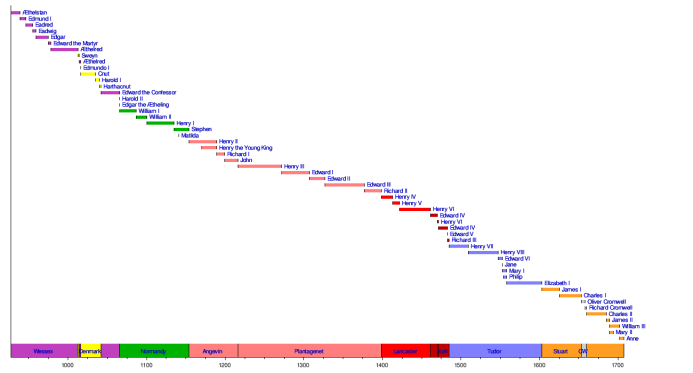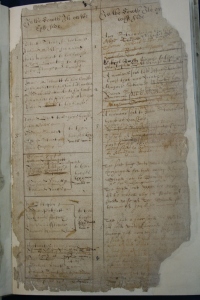Timeline of English Monarchs (Wikipedia). The idea that history is chiefly concerned with the passage of time is hardly novel!
I recently posted something about the seating plans of early-modern parish churches. The illustration I used in the post was a partial copy of a seating plan drawn up in Shepton Mallet (Somerset) in 1617, a remarkable (and rare) survival. In reflecting on how best to use this particular source, I have been forced to consider some pretty fundamental questions about the nature of the historical endeavour more generally, specifically on the importance of time (and change over time) as the bread and butter of our discipline. My overall thinking at this point is as follows: thinking about ‘change over time’ should be the main aim of historians. It is a defence against epistemological nihilism on one level and, on another, a broad claim in defence of history as a unique discipline (though not a tirade against interdisciplinarity – far from it). This is a fairly rough-hewn set of thoughts: I’ve tidied it up the best I can, but do feel free to jump in with a comment if there’s something you disagree with!
The Shepton seating plan itself provides a simple snapshot of one very specific aspect of parish life at one particular moment. It tells us the way Shepton Mallets’s parishioners organised themselves in 1617 (assuming they actually sat in their designated places). The way we are trained, as historians, means that all our primary sources are understood in much the same way – as snapshots. If we have a diary, or a relation, or a newspaper, or a woodcut image, we are encouraged to put it under the microscope and to to ask some fairly standard questions about its provenance: Who created it? For what purpose? Who is the audience? We all know that reading between the lines in this way yields much more information about the past than simply taking the source at face value, and we often learn as much – if not more – about the intentions, biases, or worldview of those creating our primary sources than about the actual subjects of those sources. We’re getting ever better at mapping the past in 3 dimensions: adding a bit of ‘depth’ to the basic ‘length and breadth’ of taking sources at face value, if you will.
To an objectivist, the purpose of doing this is to uncover or reconstruct ‘the truth’ about the past. By stripping away the faulty or misleading aspects of a source, only the truth remains. While this epistemology once dominated the historical profession, few of us would hold to such a strict position today. Most accept that instead of ‘the truth’, there are a plurality of ‘truths’, depending very much on who is observing the subject matter. The Rankeian/Eltonian notion that, with the right application of method, our primary sources give us a window on the past ‘as it essentially was’ has passed: just as a photograph is framed in a certain way by the photographer and the act of observation (and in so doing, the image of reality is distorted), so to the historical source.
So far, so nicely uncontroversial. Except that, in this world, the independence of ‘time’ and importance of ‘change over time’, quickly risk becoming redundant. Combined with very hip approaches to narratology (the study of narrative, or story-telling, structure), Histories can risk being reduced to the status of merely one tale among many. Historians appropriate the evidence which suits the story they want to tell, since it has no longer has a singular and inherent ‘meaning’, and organise their sources into a hierarchy which best conveys the message or moral the historian wants to get over to his or her reader. We have lots of texts – our sources – which exist in the present and which can be used to form any number of different stories. We have a message that we want the world to hear, and a powerful means of delivering it – the narrative. We cast the illusion of time to give weight to our story, but no more.
The problem is that this is not the way that people live, or have ever lived. The argument goes that the notion of ‘time’ is a human construct, a means to make sense of the chaos around us by ordering it into a past, present, and future. I would argue that this is what narrative is – and there’s an exciting roundtable on this going on at The Junto blog as I write – but that time itself is a fixture of reality. Time can certainly be expressed and understood as a narrative, but the two are not the same thing. The timeline above illustrates this: its a really dull and simplistic timeline of a few monarchs, 54 people from Aethelstan to Anne who took to the stage while a supporting cast of millions go unrecorded. One might even say that its just a relic from a by-gone age, where the only thing that really mattered was who sat on the throne (or, at least, from an age when someone wanted to convince us that this is what mattered). The illusion of time, in this instance, serves to reinforce the power of; a monarchical constitution? a patriarchal society? a hierarchical polity? an empire?, or whatever.
But we do more as historians than simply appropriate convenient sources, inflate them with a sense of time, and use them to reinforce powerful narratives. I’m not so sure that we should dismiss the reality and importance of ‘time’, or to conflate it with ‘narrative’. Bear with me. The seating plan exists in ‘space’ – its in the Somerset Heritage Centre in this particular present. But it also exists in ‘time’ – it was written in one present to reflect an agreement made in other presents, to guide the seating arrangements of different presents, and was amended in yet more presents. What are multiple ‘presents’, if not ‘time’? Time is, as some theoretical physicists might argue, the ‘fourth dimension’, on a par with length, breadth, and width. As well as the 3d world around us, which we can see in any snapshot, time exists to breath life into human activity. Without it we are mere waxworks, forever frozen, forever dead. One of the great things about being alive is that we are, well, alive. We move and think, things which are only possible because of this ‘fourth dimension’ which prevents us being mere fossils. Time is, in sum, what gives us our existence and makes us really, actually, real. The unificiation of the four dimensions is a fundamental part of our existence.
And bringing this fourth dimension to the table is what historians do best. Interdisciplinarity is valuable precisely because it is inter-disciplinary. To return to the Shepton Mallet seating plan, it is perhaps worth reflecting on what we might do with this source if we were not historians. The sociologist might be interested in the social organisation – the sense of hierarchy embedded in the arrangement of parish pews. The anthropologist might point out that those at the top of hierarchy sit closer to the communion table and, therefore, the ritual performance of the sacrament. The historian should take all of this on board, but above all else, should remember that she or he is interested in analysing and describing change over time. The historian thereby animates the insights provided by the sociologist or anthropologist. Is there evidence that people moved seats? Why? Did the requirements for claiming a reserved pew ever change? We are trained to hunt for the tiniest of clues which might give us an inkling about these sorts of questions and sometimes, to be sure, it can be a difficult hunt. But, without ‘change over time’, the seating plan is just another text of a dead world: there’s no existence there, there are no human beings. There are just words on a page. We have to look for the time element, else it becomes very difficult to do our job as historians.
Of course, we still have to have a lot of faith in our method to make this idea fly. We have to believe that we can come close to representing, in a present text, the stuff of the past. But once you add in the ‘time’ factor, our choices in how we shape our narratives become ever more constricted. A simple text is infinitely malleable – if it exists in space only, then by extension ‘the past’ is also highly malleable. Its just imagined by the present for present purposes, and we just select the bits we want and put it an coherent and plausible order to suit our present needs. But a text which exists simultaneously in both space and time? I would suggest that it then becomes increasingly difficult to say whatever we like about the past.


